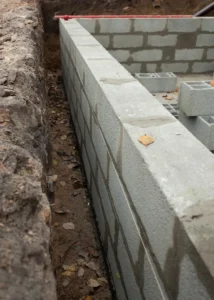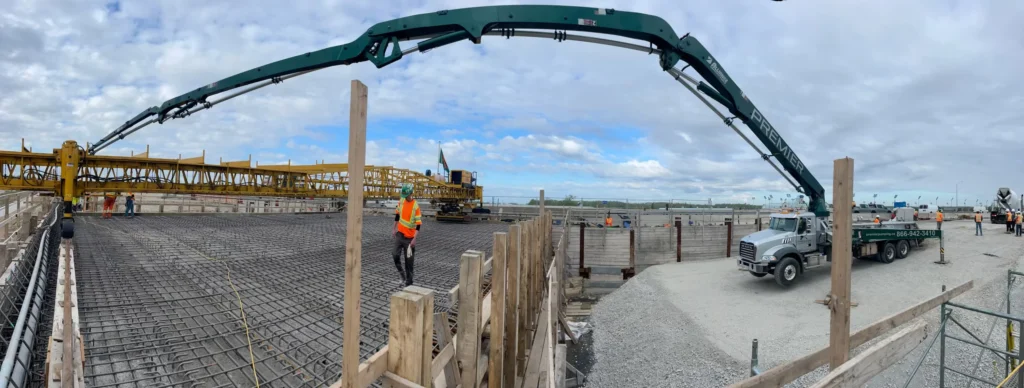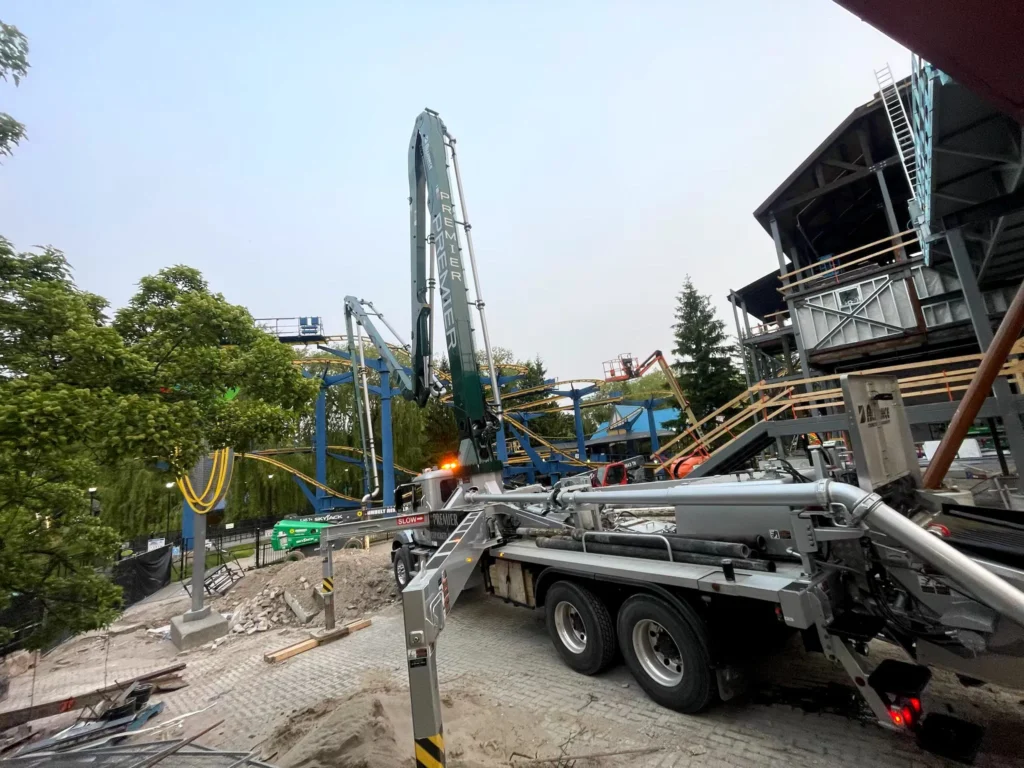At Premier Concrete Pumping, we’ve supported countless foundation projects across Southern Ontario. Whether it’s residential or commercial work, the success of any structure begins with a strong foundation. But when it comes to choosing between block foundation and poured concrete foundation, the decision isn’t always straightforward.
In this guide, we’ll break down the differences, the pros and cons of each system, and how our team ensures a smooth and efficient pour—no matter what foundation type you choose.
What Is a Block Foundation?
A block foundation, also known as CMU (Concrete Masonry Unit), is built using stacked cinder blocks. These hollow blocks are laid in rows over concrete footings, joined together with mortar. To reinforce the wall, vertical rebar is placed inside the hollow centers of the blocks, then filled with concrete.

✅ Advantages of Block Foundations
Simplified construction: Laying blocks is a straightforward process that doesn’t require specialized machinery.
Lighter materials: Cinder blocks are easier to transport than full wooden forms or pre-mixed concrete.
Strong compressive capacity: When reinforced, block walls can handle vertical loads well.
❌ Disadvantages of Block Foundations
Vulnerable to moisture: The mortar joints between blocks can crack over time, leading to leaks.
Less lateral strength: Without adequate reinforcement, block walls may bow under pressure from groundwater or shifting soil.
Slower to finish: Each block is laid manually, which can extend the project timeline on larger jobs.
If you’re tackling a block foundation job and need consistent, clean concrete pours to fill block cores, check out our concrete line pumping services for precise control on tight jobsites.
What Is a Poured Concrete Foundation?
Poured concrete foundations are formed by assembling wood or aluminum formwork on top of footings, placing rebar throughout, and then pouring concrete into the entire mold. Once it cures, the forms are stripped away, leaving a solid wall.
This method is highly popular for basements and commercial buildings due to its durability and seamless structure.

✅ Advantages of Poured Foundations
Faster for large pours: With the right equipment, entire foundation walls can be poured in one session.
Better water resistance: Fewer joints mean fewer opportunities for moisture to seep in.
Superior lateral strength: The monolithic structure holds up well against side pressure.
❌ Disadvantages of Poured Foundations
Requires specialized equipment: A boom pump is typically needed, and forms must be properly supported.
Harder to transport materials: Formwork can be bulky and time-consuming to install and remove.
Room for error in large pours: Poorly executed pours can lead to honeycombing or cold joints.
Need help selecting the right boom size? Our equipment guide helps contractors match their foundation wall height and distance with the correct pump.
When to Choose Block vs Poured Foundations
Choosing between the two depends on site conditions, project size, budget, and timelines. Here’s a quick breakdown to help guide your decision:
| Factor | Block Foundation | Poured Foundation |
|---|---|---|
| Speed | Slower | Faster with pump & crew |
| Moisture Resistance | Less resistant (more joints) | More resistant (solid structure) |
| Structural Strength | Good vertical, weaker lateral | Strong vertical and lateral |
| Installation Cost | Slightly lower in small jobs | More efficient for large builds |
| Tools Needed | Basic hand tools + rebar | Boom pump, forms, vibrators |
If you’re pouring foundations in tight residential neighborhoods, block foundations offer flexibility. For larger projects like walkout basements or commercial pads, poured foundations offer superior speed and strength.
We service both types of projects across the Greater Toronto Area and beyond—including Mississauga, Vaughan, and Markham.
Installation Differences
Block Foundation Process:
Excavate and pour footings
Apply mortar and lay first row of blocks
Stack additional rows with staggered joints
Insert rebar in hollow cores
Fill with concrete for reinforcement
Waterproof and backfill
Poured Foundation Process:
Excavate and form footings
Set up wall formwork
Add rebar (horizontal & vertical)
Pour concrete in one operation
Allow to cure (typically 7–14 days)
Strip forms and apply waterproofing
For projects requiring precision and speed, Premier Concrete Pumping can provide concrete pumping services for both block fill pours and full foundation walls using our fleet of pumps.
Why Premier Concrete Pumping Is the Right Partner
At Premier, we don’t just provide the pump—we bring peace of mind to every pour.
Here’s what makes us different:
Wide Range of Boom Pumps: From 20m to 47m, we supply the right reach for your foundation height and access.
Clean, On-Time Execution: Our experienced operators ensure pours are consistent, controlled, and vibration-ready.
All Season Work: We help our clients pour year-round with proper prep. See our best practices for cold weather pours.

Whether you’re forming a concrete basement slab, ICF foundation, or garage pad, we’ll help you pick the right equipment and method.
👉 Planning an ICF project instead? Check out our detailed guide on how to use insulated concrete forms.
Final Thoughts
Block and poured foundations both have a place in the construction world. The best choice comes down to your site conditions, crew experience, and long-term performance goals. No matter what you choose, Premier Concrete Pumping is here to support your build from footings to finish.
Let us handle the pour so you can focus on everything else.
FAQ: Block vs Poured Foundations
Q: Is a block foundation cheaper than poured concrete?
A: For small-scale projects, block foundations may be slightly cheaper due to the lack of heavy equipment needed. But in large builds, poured walls can be more cost-effective long term.
Q: Which foundation lasts longer?
A: Both types can last decades when properly built, but poured concrete tends to perform better over time due to its structural integrity and moisture resistance.
Q: Can I use a boom pump for a block foundation?
A: Yes, many block foundation jobs require precision pours between rebar-filled cavities. We often use line pumps or our smaller boom trucks for these pours.
Q: Is poured concrete stronger than blocks?
A: Yes, poured concrete typically offers superior lateral and compressive strength, especially with consistent curing and rebar integration.
